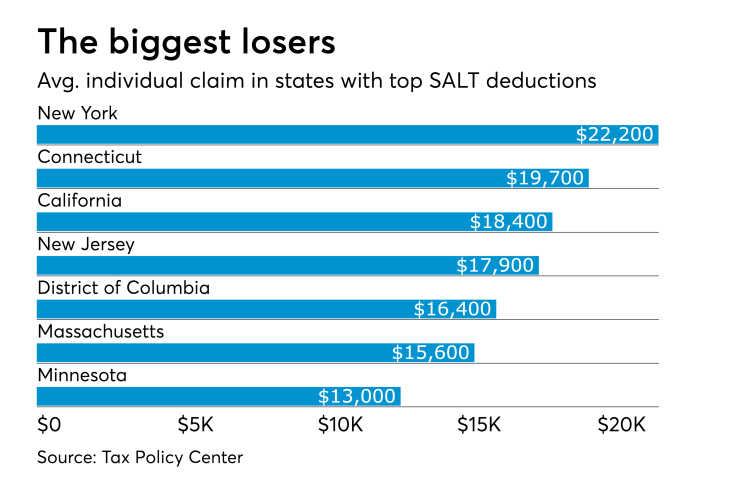The $10,000 cap on state and local tax deductions, controversial when proposed during discussions leading up to the Tax Cuts and Jobs Act, is even more so today when its impact is being fully felt.
“It’s one of the most contested provisions in the law,” said Joyce Beebe, a fellow at Rice University’s Baker Institute for Public Policy. “In fact, some believe that this issue cost at least six Republican representatives their re-election bids last November,”
While removing the SALT deduction limit would decrease federal revenue by more than $600 billion over the next decade, newly elected Democrats from high-tax states have begun discussions on either increasing or removing the cap, she noted. “The partisan nature of tax reform and the high level of fiscal deficits mean the limited SALT deductibility would have profound revenue implications, and the adversarial relationship between state and federal governments would intensify.”
“While the SALT cap can be seen both as a political move to harm blue states or a means to pay for the TCJA, there is little doubt that the federal government provides substantial financial assistance to state and local governments,” she observed.
Meanwhile, a number of states are actively seeking ways around the deduction limit, Beebe noted. “These workarounds include using charitable contributions, payroll taxes, and passthrough business taxes. The charitable contributions solution is the most widely used strategy. Because of this, it has received the most scrutiny from the Treasury,” she said.
The charitable contribution workaround converts the limited SALT deduction into an unlimited charitable donation on the donor’s federal tax return. Since the federal charitable deduction is still unlimited after tax reform, the basic idea of the workaround is to allow taxpayers to give to state-established funds, making the donations eligible for the deduction on the donor’s federal income tax return.

New York established two state funds to support health and education programs, and taxpayers may receive income tax credit of up to 85 percent of their contributions, she explained, and the state also allows local governments to create their own funds.
“New Jersey’s workaround utilizes a state credit against residents’ property taxes,” she continued. “It authorizes municipalities, counties and school districts to create charitable funds as a revenue source, which basically allows them to accept property taxes in the form of charitable contributions.”
The taxing entity then gives tax credits of up to 90 percent to the contributors.
“California allows its taxpayers to donate to the state’s Local Schools and Colleges Voluntary Contribution Fund for an 85 percent credit,” she said. “Oregon’s approach is a charitable contribution with a twist. Its Oregon Opportunity Grant credits are auctioned annually, giving donors only a chance at getting a tax break in exchange for their donation. “
The charitable contribution workaround is probably the weakest, because the Treasury has specifically attacked it, Beebe said. Stronger, perhaps, is the payroll tax deduction, which converts the limited SALT deduction into an unlimited employer payroll tax deduction. “Businesses, however, do not favor this approach, because of its administrative and conceptual complexity,” she said. “In addition, it would not apply to self-employed workers.”
The passthrough workaround may be the strongest, Beebe indicated: “It converts the limited SALT deduction into an unlimited passthrough business expense deduction. Because state and local taxes paid in connection with conducting a trade or business also are considered business expenses, they are unlimited and deductible on federal income tax returns. By taxing the passthrough business entities directly, this basically trades the limited taxpayer-level SALT deduction for an unlimited entity-level business expense deduction on federal returns.”
“Some of the workarounds may prevail on legal grounds, but whether they make good state tax policy is a separate matter,” Beebe said. “Key state-level issues on both revenue and expenditures need to be addressed. The growing spending on entitlement and the looming budget shortfalls require not only efficient administration but also a reconsideration of spending priorities.”





